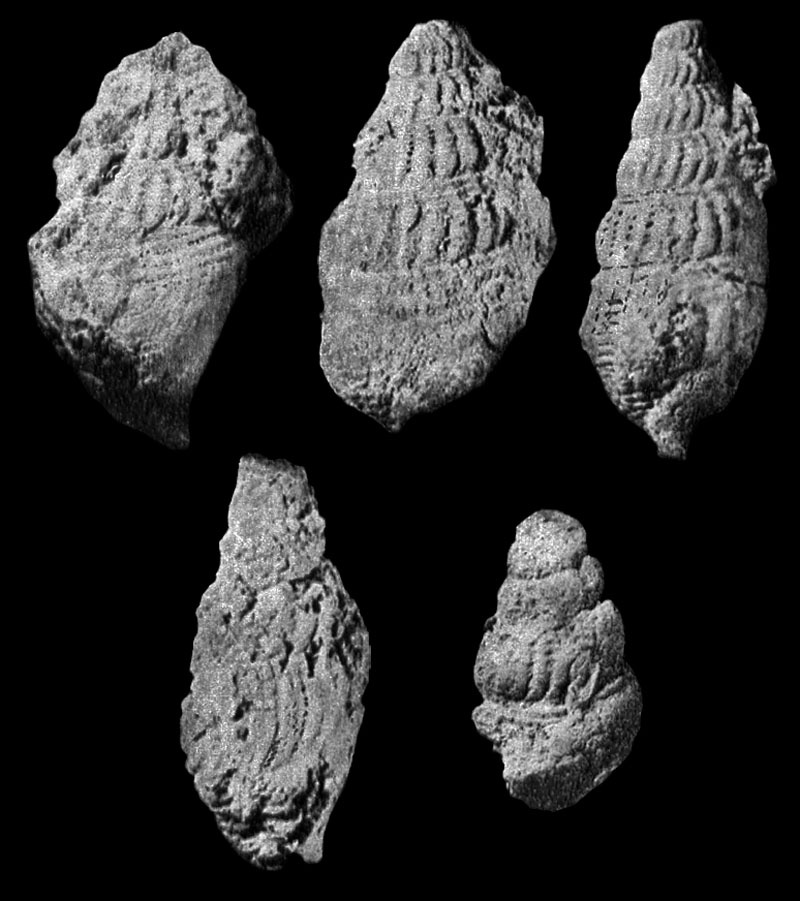Stromboidea
Original Description of Aporrhais (Helicaulax) themedensis by Abbass, 1963
- "The shell is of medium size. The spire is elongated and consists of about 8 whorls which are convex in outline. The sutures are slightly furrowed and the whorls are overlapping. The ornament consists of 18-20 opisthocline axial ridges with an opisthocyrt curvature. They show a tendency to taper posteriorly. The spiral cords, which are about 10 in number, are much thinner than the axials and are separated by interspaces less than their own width. The posterior spiral is the most prominent and is placed close to the suture. The intersection of the spiral and axial ornament produces tubercles which are elongated in a spiral direction The height of the body whorl is about one third of that of the shell and tapers anteriorly to form the anterior canal. Its surface is crossed by a large number of spirals of the same nature as those on the spire, but secondary spirals may appear in their interspaces. The axials become reduced in strength and may be represented by growth rugae which are opisthocyrt posteriorly, but present a prominent convexity anteriorly. A spiral cord which is hidden on the spire appears on the middle of the body whorl as a distinct keel."
Locus typicus: Themed, Sinai, Egypt
Stratum typicum: Santonian, upper Cretaceous
Aporrhais (Helicaulax) themedensis Abbass, 1963, pl. 6, fig. 1-5
History and Synonymy
2002
Kora et al., 2002, p. reported Aporrhais themedensis from the Metatissotia foumeli Zone, which is recorded from the middle member of the Matulla Formation (upper Coniacian), ranging in thickness from about 12m at Wadi Feiran to 55m at Wadi Matulla
2006
G. El Qot, 2006, p. 102 about Helicaulax themedensis:
- "Shell small to medium-sized, spindle-shaped. Spire relatively high and composed of about 4 to 6 overlapping whorls, which are convex in outline. Body whorl carinate, moderately inflated and accounting for about 1/3 of shell height. Suture slightly impressed. Ornamentation consisting of 16-20 opisthocline axial ribs. These are crossed by a variable number of relatively finer spiral cords and separated by narrower interspaces, which are occupied by very fine spiral threads. The intersection of both axial and spiral elements produces tubercles, which are elongated in a spiral direction. Aperture small, lanceolate, with incomplete outer lip.
- Age. Coniacian-Santonian.
- Distribution in Egypt. Themed area, Farsh El-Ghozlan,Wadi Sudr, and Magmar."
References:
- Abbass, 1963
- El Qot, G. M. 2006. Late Cretaceous macrofossils from Sinai, Egypt. – Beringeria 36: 3-163, 11 text-figs., 1 tab., 34 pls.; Würzburg.
- M. Kora, H. Hamama & H. Sallam, 2002. Senonian Macrofauna from West-Central Sinai: Biostratigraphy and Paleobiogeography; Egypt. Jour. Paleontol., Vol. 2, 2002, p. 235-258.

